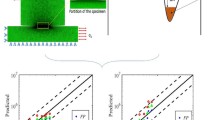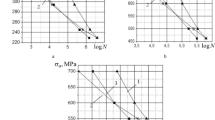Abstract
Fretting can occur when repeated loading on a structure or part causes repetitive relative movement at contacting metallic surfaces. The fretting process may cause local metal loss and impact the initiation and/or propagation of fatigue cracks. There are some features of fretting-fatigue cracking that are unique. Several of these features are illustrated in three case histories described in this paper: the failure of a splined papermaking refiner shaft, the failure of two coal-pulverizer shafts, and the cracking of a crankshaft flange from a ship’s engine. Fretting fatigue usually results in recognizable damage to at least one of the contacting surfaces. The fretted areas are roughened and, in steel, are usually decorated with reddishbrown deposits. Cracks may be initiated in the damaged region but are located close to the boundary between the damaged areas. Cracking normally starts at an angle of less than 90° to the surface. The geometric stress concentrations present on the component may be overridden because of fretting, and cracks may initiate on previously smooth surfaces. Some cracks may initiate and grow to only a shallow depth before ceasing propagation.
Similar content being viewed by others
References
R.B. Waterhouse:Fretting Fatigue, 1st ed., R.B. Waterhouse, Ed., Applied Science Publishers, Barking, Essex, England, 1981, pp. 203–19.
T. Juuma: “Torshional Fretting Fatigue Strength of a Shrink-Fitted Shaft with a Grooved Hub,”Tribol. Int., 2000,33, pp. 537–43.
F.R. Hutchins:Failure Analysis: The British Engine Technical Reports, 1st ed., F.R. Hutchins and P.M. Unterweiser, Ed., American Society for Metals, Metals Park, OH, 1981, p. 454.
G.M. Spink: “Fretting Fatigue of a 2 1/2% NiCrMoV Low Pressure Turbine Shaft Steel: The Effect of Different Contact Pad Materials and of Variable Slip Amplitude,”Wear, 1990,136, pp. 281–97.
B. Yang and S. Mall: “On Crack Initiation Mechanisms in Fretting Fatigue,”J. Appl. Mech. (Trans. ASME), 2001,68, pp. 76–80.
V. Lamacq, M.C. Dubourg, and L. Vincent: “A Theoretical Model for the Prediction of Initial Growth Angles and Sites of Fretting Fatigue Cracks,”Tribol. Int., 1997,30(6), pp. 391–400.
J. Dobromirski and I. Smith: “A Stress Analysis of a Shaft with a Press-Fitted Hub Subjected to Cyclic Axial Loading,”Int. J. Mech. Sci., 1986,28(1), pp. 41–52.
K. Kondoh and Y. Mutoh: “Fretting Fatigue: Current Technology and Practices,” ASTM STP 1367, D.W. Hoeppner, V. Chandrasekaran, and C.B. Elliot, Ed., ASTM, West Conshohocken, PA, 2000, pp. 282–92.
L.J. Fellows, D. Nowell, and D.A. Hills: “On the Initiation of Fretting Fatigue Cracks,”Wear, 1997,205, pp. 120–29.
J.D. Costa, J.M. Ferreira, and A.L. Ramalho: “Fatigue and Fretting Fatigue of Ion-Nitrided 34CrNiMo6 Steel,”Theor. Appl. Fract. Mech., 2001,35, pp. 69–79.
C.X. Li, Y. Sun, and T. Bell: “Factors Influencing Fretting Fatigue Properties of Plasma-Nitrided Low Alloy Steel,”Mater. Sci. Eng. A, 2000,292, pp. 18–25.
Author information
Authors and Affiliations
Rights and permissions
About this article
Cite this article
Chan, P.C., Thornley, J.C. Common features of fretting-fatigue cracking in steels. Practical Failure Analysis 2, 85–90 (2002). https://doi.org/10.1007/BF02715504
Received:
Revised:
Issue Date:
DOI: https://doi.org/10.1007/BF02715504




